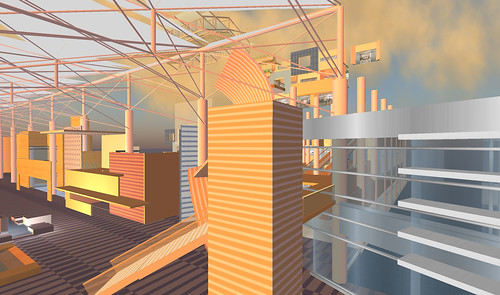
Written by DB Bailey (David Denton Architect):
In the larger sense, I don’t know why we are here. Two years ago, my name appeared on a short list of international architects approved by the Egyptian government for planning projects here. My first reaction was suspicion, especially when I received the same week an invitation to come work in Nigeria, which quickly proved to be a scam.
It seemed particularly curious that my name would be on a list of seventeen firms, most of which were huge international enterprises. I was amused to learn when first arriving in Cairo that my client’s assumption was that my firm was of comparable size. What a shock when he found out I had only one employee! I may never know why I was chosen; even the Egyptian government could not explain why I was on the list.
Two Cairo firms, Hamza Associates and PUD Consultants, were asked by the Egyptian government to submit proposals and contacted me. Hamza Associates is a storied firm known for its work on the Alexandria Library. PUD Consultants is smaller and younger. Its owner, Amr Attia, had recently received an Eisenhower Fellowship to study planning in the United States and covered 25 cities in two months. I showed him around Los Angeles when he visited there.
By now I have worked on two projects with Hamza Associates. But my current client, Mohamed Abou el Enein, president of Cleopatra Ceramica, preferred my recommendation of Amr Attia and PUD Consultants for the executive architect position on this latest project: a shopping center, hotel, theater, and office park complex in the new Cairo suburb Sixth of October City. So here I am again, living as Enein’s guest in a suite at the Four Seasons Nile Plaza Hotel, going off to work in Amr’s office in Zamalek.
My wife Judith is with me.
I meet regularly with Abou el Enein, usually at his villa on the Nile, amid Italian marble splendor, sipping Turkish coffee, frequently late at night, as Egyptians never seem to sleep. Enein, who has built a ceramics empire selling products all over the world, flies his own Gulfstream jet, works two cell phones at the same time, one for each ear, never seems to lack for energy, and loves the idea of pioneering in the virtual world.
The staff at PUD Consultants are working with me to build the first phase of the project on Second Life®. I have been working in Second Life for about two years, and have done projects for McKinsey & Company and Stanford University Library, among others. These SL projects were produced while maintaining an RL practice in architecture and planning. My goal for some time has been to integrate these two worlds and to utilize SL for designing an RL project.
It took some time to work up the nerve to actually try it and to find a client willing to go along for the ride. In addition, I was waiting for a project or design challenge that truly justified using SL as opposed to other 3d modeling programs, such as 3d max, which I normally use. I also found that I was falling back into old, bad habits working with 3d max. I tend to determine the key views for the final rendering early in the 3d modeling process and then design the project for those several key views. The rest suffers from lack of attention.
The first phase of the Cairo project is the shopping mall. Shopping malls in the United States are changing rapidly, away from the “mall look” and more toward recreations of traditional shopping streets. Even though Egypt is somewhat behind the United States in terms of shopping trends, I did not wish to be building a dinosaur that would quickly be out of fashion. So I designed an interior shopping arcade space meant to be reminiscent of a Mediterranean village, inspired by quaint shopping districts in such places as Capri and Positano.
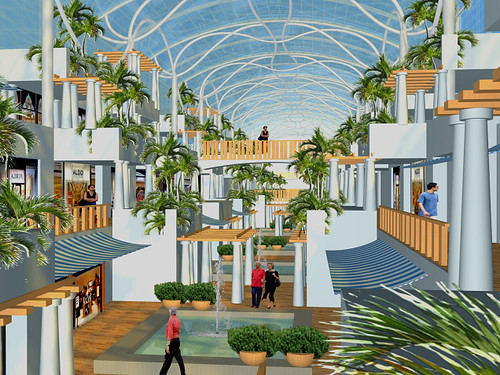
Initially I built the space in 3d max and produced several renderings that I showed to the client. The client seemed to have difficulty understanding the space, as I had to admit, I myself was experiencing too. The project seemed imperiled; so I decided, now is the time to try SL as a design tool. It worked. The client was happy and we were on our way back to Cairo.
This project needed to be experienced dynamically by moving through the space. Fortunately, the client had recently heard about the possibilities in the virtual world and had been told he could put his products (ceramics such as bathroom fixtures and tiles) into a virtual world catalog. This discussion led to an agreement to try SL as a design tool for the project.
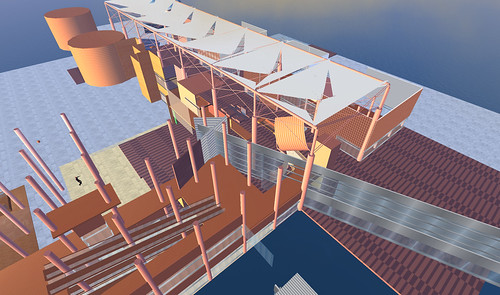
I was surprised how quickly the first pass build actually went, as compared to working with 3d max. As a design tool, SL has proven to be invaluable. Constantly moving through the space, examining it from various angles, has improved the overall design quality. There are of course drawbacks, such as no shadows, difficulty working with curved forms, accurate measurements, availability of SL in Egypt, etc. One of the difficulties in working with SL is my tendency to design the project for what can be built given the limitations of SL tools. Thus the final judgment of how useful this is remains to be seen.
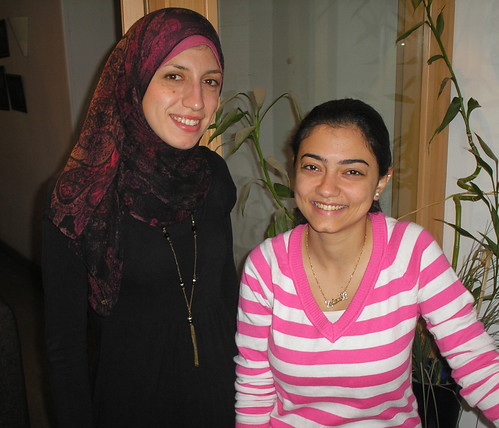
Co-captains of the Egyptian SL building team: on the left Iman Sabbour (aka in sl Amy Ranimodo) on right Zeinab Hussein (aka in sl Ouzoo Carlucci)
Perhaps the ultimate test is not just how useful it is for the architect as a design tool, but will it have a life beyond? The dream is for the client to use the final build for promoting the project and leasing tenant space. His company, Cleopatra Ceramica, could use the larger spaces to exhibit their products, a virtual website. The company advertises extensively throughout the Middle East and could incorporate a reference to the virtual site in their advertising. But all of this is in the future.
Right now, we are simply using it as a design tool. As such, we are constantly making changes, leaving behind more of a 3d sketch than a presentable product. If it does have a life beyond the design process, it will probably have to be rebuilt – a major concern.
The project is over 400 meters long. We are building only half of it in Second Life, as it is more or less symmetrical. But the other half will have to be built eventually. Because of the size, the land costs in SL are a consideration. Not cheap, but not a major cost if it proves to be an effective marketing tool. No one knows at this point.
I will continue to submit dispatches as we move along, telling you more about what we have learned about the pros and cons of working with SL as a design tool. At the moment, I can’t say for sure where it’s headed.

Attached are some photographs of our progress. Also included is a photograph of the site, which is mostly sand, on which the owner has erected, in true pharaonic style, a giant billboard approximately 60 feet tall and 400 feet long, awaiting renderings of the proposed project. The resolution of SL renderings on a laptop screen is one thing, but blown up to that scale is quite another. It remains to be seen whether this will have to be rebuilt in 3d max in order to produce sufficient quality renderings. We’re all a bit nervous about how that is going to turn out.
Nothing in this part of the world seems to be on a small scale. In the spirit of the great Egyptian builders, the front façade of this project will be a gigantic electronic sign, sitting in the middle of a lake, with its reflection visible from the main entry. The name of the project is, in fact, “Reflections.” One will drive into the lake, into the reflection of the sign, to enter the parking garage. SL provides the opportunity to see this representation with an actual moving video on the electronic sign and the sound of splashing fountains, allowing the viewer to have a more complete experience than a 3d rendering could ever portray. I hope to be far enough along by next week to make a design presentation to the client that will comprise a walk through with avatars and no drawings, not even plans.
Working in the office of PUD Consultants with Amr Attia and a team of young Egyptian architects has been a fantastic experience in so many ways. The practice of architecture in Egypt is quite different and yet SL seems to diminish those differences. There’s something very bizarre about leaving Los Angeles for faraway Egypt, saying goodbye to my SL friends, and then never really leaving them because we are together in SL.
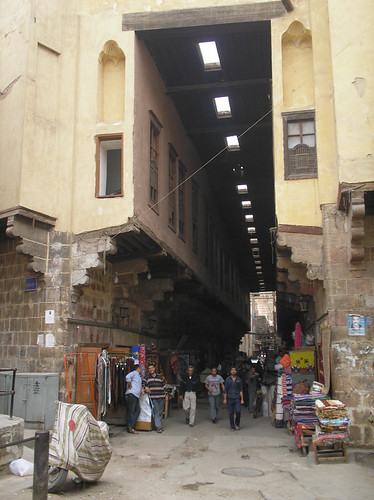
Initially I resisted a long stay (as requested by the client in Cairo), which this trip is now turning out to be, because I believed that producing the design in the virtual world was viable and loyal to the ideal. Actually designing the project in Cairo has convinced me that physical presence in the local culture is invaluable. Judith and I have been spending what little time I have had off from work exploring Cairo, particularly the historic Islamic districts, studying ancient marketplaces such as the Caravanserai and incorporating some of the ancient and traditional materials and patterns. One day last week was spent in the Khan el Khalili bazaar with narrow, crowded streets and visual cacophony of products, stacked and hanging everywhere. The end of the day was spent at City Stars, a contemporary indoor shopping mall typical in the United States, where this model is now considered obsolete.
One conclusion that I have reached is that the narrow shopping streets with the visual stimulation of product displays make for a much more interesting experience. Thus I reduced the widths of the walking areas from the traditional shopping mall to intensify that experience. Many other elements of traditional souks have been incorporated, such as dappled light patterns from overhead trellis canopies, extensive use of wood and storefronts as open as possible.
Tiles from the owner’s company, Cleopatra Ceramica, will be used extensively throughout the project, which will in effect become a showroom for their products. The architectural interest and variety will be achieved more through the use of these tiles in unique patterns rather than extensive architectural ornamentation. I will also be designing new architectural tiles for the company.
Everyone is welcome to come visit and meet us in Second Life, DB Bailey and the Egyptian crew. We would also very much like to hear about any experiences you have had designing RL projects in SL, and advice you may have for us.
Questions to be answered in future dispatches: Will this project keep going, contrary to most other development projects of this size around the world in this economy? Will the client in the end find SL as a vehicle to be useful and cost-effective? Will we in the end find it cost-effective as a design tool? Will we get back to Los Angeles before the searing heat of the Sahara? Will it be convincing as a presentation tool for the client to promote the project? Will the client get his own avatar and spend time himself exploring the design? Will our dog still remember us? Will we ever tire of hearing how much the Egyptians love Obama?
To visit the virtual site, click this SLurl. If you don’t already have an account, click ‘Sign Up’ in the upper right corner of this page:

